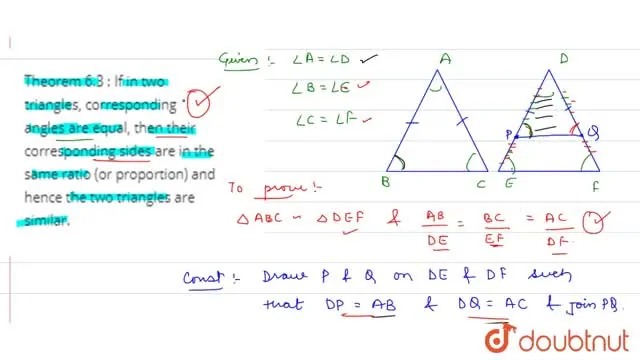Theorem 6.3 : If in two triangles, corresponding angles are equal, then their corresponding sides are in the same ratio (or proportion) and hence the two triangles are similar.
Step by step video, text & image solution for Theorem 6.3 : If in two triangles, corresponding angles are equal, then their corresponding sides are in the same ratio (or proportion) and hence the two triangles are similar. by Maths experts to help you in doubts & scoring excellent marks in Class 10 exams.
Related Playlists
- BOOK - NCERTCHAPTER - NCERT THEOREMSEXERCISE - THEOREM 10.12videos
NCERT THEOREMS
- BOOK - NCERTCHAPTER - NCERT THEOREMSEXERCISE - THEOREM 1.31videos
NCERT THEOREMS
- BOOK - NCERTCHAPTER - INTRODUCTION TO TRIGONOMETRYEXERCISE - EXERCISE 8.37videos
INTRODUCTION TO TRIGONOMETRY
- BOOK - NCERTCHAPTER - PAIR OF LINEAR EQUATIONS IN TWO VARIABLESEXERCISE - EXERCISE 3.78videos
PAIR OF LINEAR EQUATIONS IN TWO VARIABLES
Similar Questions
Two triangles are similar if their corresponding sides are ………….
View SolutionIf the angles of a triangle are in the ratio 1:2:3,the corresponding sides are in the ratio
View SolutionIf the angles of a triangle ABC are in the ratio 1:2:3. then the corresponding sides are in the ratio ?
View SolutionTheorem 6.5 : If one angle of a triangle is equal to one angle of the other triangle and the sides including these angles are proportional, then the two triangles are similar.
View SolutionIf area of two similar triangle are equal then ratio of their corresponding altitude is.
View SolutionIf two triangles are similar; prove that the ratio of the corresponding sides is same as the ratio of corresponding medians.
View SolutionTwo isosceles triangles have equal vertical angles and their corresponding sides are in the ratio of 3:7. What is the ratio of their areas?
View SolutionIn two right triangles one side an acute angle of one are equal to the corresponding side and angle of the other. Prove that the triangles are congruent.
Let ABC and DEF be two right triangles such that
∠A=∠D,BC=EFand∠B=∠E=900
Thus, in △s ABC and DEF<br>/_A=/_D<br>/_B=/_E=90^0<br>BC=EFSo,by∀S≅ruencecriterion,weobta∈<br>/_\ABC~=/_\DEFView SolutionIf the angles of a triangle are in the ratio 1:2:3,the corresponding sides are in the ratio
View SolutionIf two triangles are similar; prove that the ratio of corresponding sides is equal to the ratio of corresponding altitudes.
View Solution


